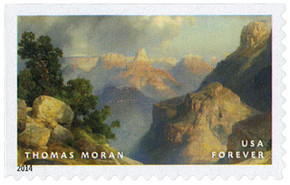
U.S. #4917-20
2014 49¢ Hudson River School Paintings
American Treasures
These stamps are the 12th issue in the American Treasures series. The artwork includes the 1912 Thomas Moran painting “Grand Canyon”; “Summer Afternoon” painted by Asher B. Durand in 1865; the 1856 oil painting “Sunset” by Frederic Edwin Church; and the 1830 oil painting ... more
U.S. #4917-20
2014 49¢ Hudson River School Paintings
American Treasures
These stamps are the 12th issue in the American Treasures series. The artwork includes the 1912 Thomas Moran painting “Grand Canyon”; “Summer Afternoon” painted by Asher B. Durand in 1865; the 1856 oil painting “Sunset” by Frederic Edwin Church; and the 1830 oil painting “Distant View of Niagara Falls” by Thomas Cole.
The so-called Hudson River School of Landscape Painting emerged in the United States in the late 1820s as an artistic celebration of nature in its purest form. As artists began painting portrait subjects in front of backgrounds of hills, streams, and trees, the natural settings took over as the focal point. Landscape painting became a major style of art in itself.
The Hudson River School was named to identify the movement toward landscape painting and to classify artists of this style. Many of the artists worked or lived near the Hudson River area of New York City and often would travel to the country for inspiration. The vast, unspoiled landscapes of the mid-19th century Hudson River Valley and Catskills regions offered perfect subject matter for the new artistic focus.
Hudson River artists used invisible brushstrokes to capture the most minute details of nature on the grandest scale. Their paintings feature tranquil landscapes under blue skies, often illuminated by a sunrise or sunset.
The style dominated the art world for the better part of the 19th century. Considered the first truly American style of art, the Hudson River School of Landscape Painting is still a preferred style among many art enthusiasts.
49¢ Hudson River School, issued to satisfy the first-class mail rate
Issue Date: August 21, 2014
City: Hartford, CT, at the American Philatelic Society Stamp Show
Quantity: 100 million
Category: Commemorative
Printed By: CCL Label
Printing Method: Photogravure
Perforations: Serpentine Die Cut 10¾
Self-Adhesive
Happy Birthday, Albert Bierstadt
Artist Albert Bierstadt was born on January 7, 1830, in Solingen, Germany.
Bierstadt’s family moved to America the following year, settling in New Bedford, Massachusetts. Bierstadt had an interest in art from an early age, making detailed drawings in crayon when he was a child.
Bierstadt began oil painting in 1851, and two years later returned to Germany to study at the Dusseldorf Academy for several years. In 1857, he returned to New Bedford to teach drawing and painting for a short time before deciding to become a full-time painter.
As he gravitated toward capturing landscapes and the unique effects of natural lighting, Bierstadt took to painting upstate New York and New England scenes, joining the Hudson River School Art Movement. Named for the area where their style first developed during the early 1800s, these artists created romantic scenes of unspoiled nature. Like most of the group, Bierstadt had a studio in New York City. From there, he traveled to the nearby Hudson River area to paint its beautiful uninhabited mountains, lakes, and forests. Bierstadt became the most financially successful of all the Hudson River School artists.
Soon Bierstadt craved new scenery, so he joined the Westward expedition of Colonel Frederick Lander in 1859. The goal of the expedition was to plot a wagon route from Wyoming to the Pacific. Bierstadt traveled as far as the Rocky Mountains, making on-the-spot sketches of Native Americans, emigrants, animals, and landscapes.
Bierstadt then returned to New York City and began transforming his drawings and pictures into huge landscapes, some 6 by 10 feet in size. Bierstadt captured the majesty of the American West, glorifying its pristine landscapes, wild animals, and Native Americans. Using a technique called luminism, Bierstadt bathed water and sky in exaggerated light, portraying America as the new Garden of Eden. These first western paintings were an instant success, and Bierstadt would make several more trips west during his lifetime.
Bierstadt was drafted during the Civil War and paid a substitute to serve in his place. He did spend some time with soldiers, producing the painting Guerrilla Warfare, Civil War, which received positive reviews.
In 1867, Bierstadt went to London and displayed two of his paintings in a private viewing with Queen Victoria. He then spent two years traveling through Europe gaining support for his work and promoting the American West as a place of promise, which has been credited with increasing European emigration. Back in America, his paintings of the Yosemite Valley generated significant publicity for the area, leading many explorers to request his services on their westward expeditions. He was also hired by the Atchison, Topeka, and Santa Fe Railroad to visit and paint the Grand Canyon.
Bierstadt’s wife was diagnosed with tuberculosis in 1876. From then until her death in 1893, they lived in Nassau, Bahamas. During this time, Bierstadt’s work dropped in popularity and was criticized for being too theatrical. A fire then destroyed many of his paintings in 1882. Bierstadt, who had produced over 500 paintings during his lifetime, died on February 18, 1902, and was largely forgotten for several decades. In the 1960s, some of his small oil paintings were exhibited, generating a new appreciation for his talent and art. One critic noted that his “theatrical art, fervent sociability, international outlook, and unquenchable personal energy reflected the epic expansion in every facet of western civilization during the second half of the nineteenth century.”
Less
Most Orders Ship
within 1 Business Day
90 Day Return Policy
Satisfaction Guaranteed
Earn Reward Points
for FREE Stamps & More







